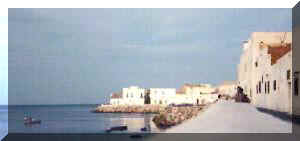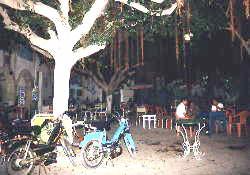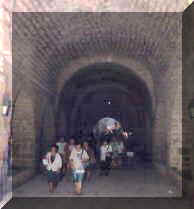
 The
promise of Mahdia has a tendency of coming almost true. While wandering
around the city, many of the elements of the city's past is spotted, but
it either is too obviously restored, or too little. In the 10th century
Mahdia was a very important city, but even more, it was the capital of one
of the Muslim worlds most important line of rulers, the Fatimids. The
first Fatimid ruler declared himself as the Mahdi, the last prophet of
Islam.
The
promise of Mahdia has a tendency of coming almost true. While wandering
around the city, many of the elements of the city's past is spotted, but
it either is too obviously restored, or too little. In the 10th century
Mahdia was a very important city, but even more, it was the capital of one
of the Muslim worlds most important line of rulers, the Fatimids. The
first Fatimid ruler declared himself as the Mahdi, the last prophet of
Islam. The Fatimids moved their centre to Egypt after conquering Cairo, and
Mahdia had been the capital for just 50 years.
The Fatimids moved their centre to Egypt after conquering Cairo, and
Mahdia had been the capital for just 50 years.

Mahdia
was chosen as the capital because of the proximity to the sea, and the
promontory on which an important military settlement had been since the
time of the Phoenicians. With a wall 10 metres thick, man and nature had
built one of this coast's best fortresses. The move of the Fatimids did
mean that it was less thoroughly defended, and invasions by Christians,
Normans and Turks in the following centuries lead to heavy destruction of
the original bastion.
 Entering
today's Mahdia is greatest part of the visit. As you pass through the 10 meter
thick wall, that functions as the gate to the city, history feels close.
The city never opens after this, and all over Mahdia narrow streets never
extends beyond small squares. Mahdia's great charm are the narrow streets,
trees, the life of the locals, the cafés. The only really open part of
the city is in front of the Great Mosque, which is only great in size,-
otherwise it is a sad attempt to reconstruct the mosque of the first
Fatimids. The base of the old city of Mahdia is not tourism, but weaving.
In the Arab world, quarters and cities often specialized in one product
which they sold widely around, and Mahdia has a large part of the
production of wedding cloth for the rest of Tunisia.
Entering
today's Mahdia is greatest part of the visit. As you pass through the 10 meter
thick wall, that functions as the gate to the city, history feels close.
The city never opens after this, and all over Mahdia narrow streets never
extends beyond small squares. Mahdia's great charm are the narrow streets,
trees, the life of the locals, the cafés. The only really open part of
the city is in front of the Great Mosque, which is only great in size,-
otherwise it is a sad attempt to reconstruct the mosque of the first
Fatimids. The base of the old city of Mahdia is not tourism, but weaving.
In the Arab world, quarters and cities often specialized in one product
which they sold widely around, and Mahdia has a large part of the
production of wedding cloth for the rest of Tunisia.